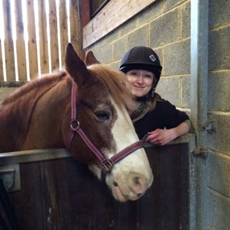Smile and a horse will smile with you – literally
11 Feb 2016
Horse fanciers over the ages may have known this instinctively – but psychologists have shown for the first time that horses are able to distinguish between positive and negative human facial expressions.
 Look angry and a horse is likely to give you a sideways glance, using its left or sinister side. Its heart rate will increase, too. And both are indications that a horse can recognise a human emotion.
Look angry and a horse is likely to give you a sideways glance, using its left or sinister side. Its heart rate will increase, too. And both are indications that a horse can recognise a human emotion.
Psychologists at Sussex University, who last year compiled a dictionary of the facial expressions that might indicate emotions in a horse, report that they have just turned the experiment on its head - they have explored the equine capacity to read a human face.
And man's favourite neigh-sayer can not only tell whether a human might be in a bad mood, it can do so from a photograph.
The scientists report in the journal Biology Letters that they made high quality, large size colour prints of the same male human smiling and baring his teeth, and frowning and baring his teeth - expressions of positive and negative emotions from a stranger.
Volunteers – who did not themselves know what the photograph revealed – showed them to 28 horses from five riding or livery stables in Sussex and Surrey. And the horses could tell the difference.
''What's really interesting about this research is that it shows horses have the ability to read emotions across the species barrier. We have known for a long time that horses are a socially sophisticated species but this is the first time we have seen that they can distinguish between positive and negative human facial expressions,'' said Amy Smith, a doctoral student in the university's mammal vocal communication and cognition research group.
''The reaction to angry facial expressions was particularly clear – there was a quicker increase in their heart rate, and the horses moved their heads to look at the angry faces with their left eye.''
Dogs have been shown to look at angry human faces with the left eye: the reasoning is that the brain's right hemisphere – where information from the left eye is recorded and interpreted - is specialized for dealing with scary or threatening stimuli.
Sheep have been shown to recognize and be calmed by photographs of other sheep, and even to remember faces of sheep and humans.
But the horse research takes such studies into new territory, if only because horses have already been shown to produce their own complex facial expressions that might reflect mood.
''These findings raise interesting questions about the nature of emotional expression recognition, including the relative roles of learning and innate skills in its development,'' the scientists say.
Karen McComb, who heads the research group and is co-lead author of the study, said, ''Horses may have adopted an ancestral ability for reading emotional cues in other horses to respond appropriately to human facial expressions during their co-evolution. Alternatively, individual horses may have learned to interpret human expressions during their own lifetime.''
(See: Horses can read human emotions, Sussex research shows)






.webp)















